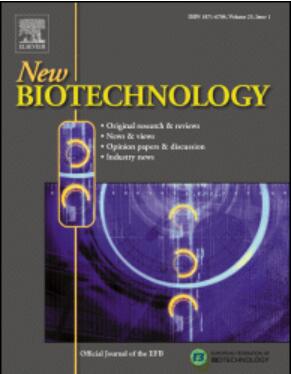利用控制偏差确定生物生产改进的初始目标。
IF 4.9
2区 生物学
Q1 BIOCHEMICAL RESEARCH METHODS
引用次数: 0
摘要
生物过程代谢反应网络分析的敏感性分析允许预测系统参数,例如与某些反应步骤的酶活性相关的参数,这些参数会显著影响整体生产。然而,动力学速率表达式和由此产生的稳态通量分布的不确定性限制了这些预测的准确性。从最小信息出发(反应化学计量学、系统内外的外部通量和平衡阶段的潜在识别),提出了一种利用弹性和代谢通量采样来计算控制偏差的新初步方法。计算出的控制偏差识别出可能有正控制、负控制或可忽略/不确定控制的步骤。这是为了在进行进一步详细调查之前提供初步指导,确定任何生物体的目标,以提高有价值化学品的生产。将该方法应用于琥珀酸放线菌的生物琥珀酸生产,并成功地揭示了对生物琥珀酸生产产生最大正、负影响的反应步骤。本文章由计算机程序翻译,如有差异,请以英文原文为准。
Using control bias to identify initial targets for bioproduction improvement
Sensitivity analysis of bioprocess metabolic reaction networks analysis allows the prediction of system parameters such as those associated with the enzyme activity of certain reaction steps which significantly affect the overall production. However, uncertainties in kinetic rate expressions and in the resulting steady-state flux distributions limit the accuracy of these predictions. Starting from minimal information (reaction stoichiometry, and external fluxes in/out of the system and potentially identification of steps at equilibrium) a new preliminary method is proposed using sampling of elasticities and metabolic fluxes to calculate the control bias. The calculated control bias identifies steps which are likely to have positive control, negative control or negligible/uncertain control. This is intended to give initial guidance before further detailed investigation is carried out, identifying targets for any organism to enhance production of valuable chemicals. As a case study, this methodology is applied to succinic acid bioproduction using Actinobacillus succinogenes and analysis successfully reveals the reaction steps having the greatest positive and negative influence on biosuccinic acid production.
求助全文
通过发布文献求助,成功后即可免费获取论文全文。
去求助
来源期刊

New biotechnology
生物-生化研究方法
CiteScore
11.40
自引率
1.90%
发文量
77
审稿时长
1 months
期刊介绍:
New Biotechnology is the official journal of the European Federation of Biotechnology (EFB) and is published bimonthly. It covers both the science of biotechnology and its surrounding political, business and financial milieu. The journal publishes peer-reviewed basic research papers, authoritative reviews, feature articles and opinions in all areas of biotechnology. It reflects the full diversity of current biotechnology science, particularly those advances in research and practice that open opportunities for exploitation of knowledge, commercially or otherwise, together with news, discussion and comment on broader issues of general interest and concern. The outlook is fully international.
The scope of the journal includes the research, industrial and commercial aspects of biotechnology, in areas such as: Healthcare and Pharmaceuticals; Food and Agriculture; Biofuels; Genetic Engineering and Molecular Biology; Genomics and Synthetic Biology; Nanotechnology; Environment and Biodiversity; Biocatalysis; Bioremediation; Process engineering.
 求助内容:
求助内容: 应助结果提醒方式:
应助结果提醒方式:


